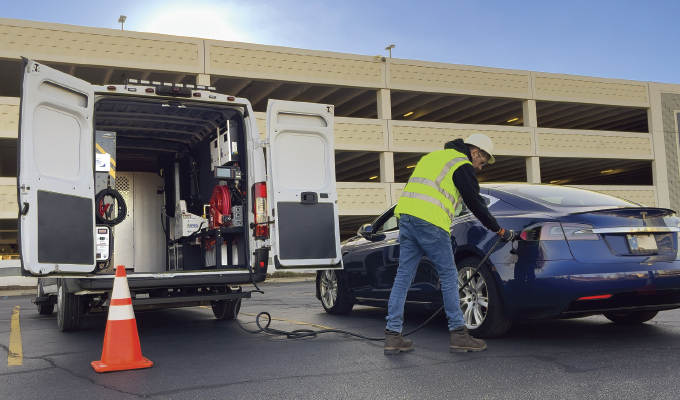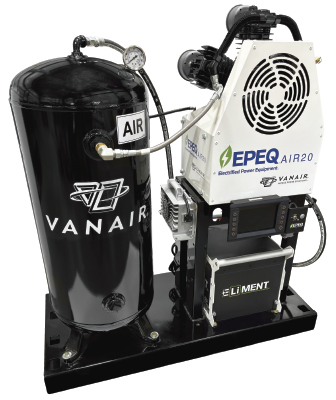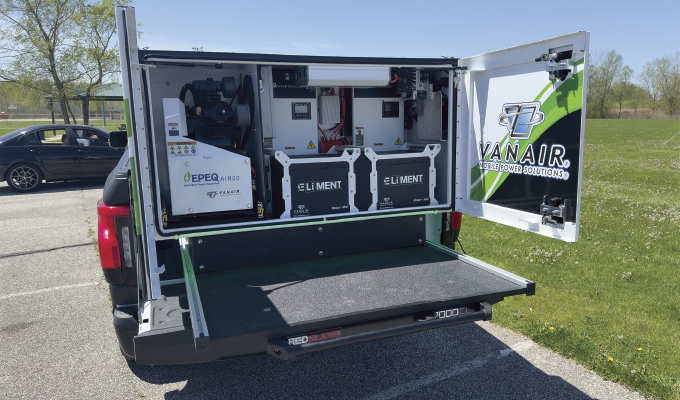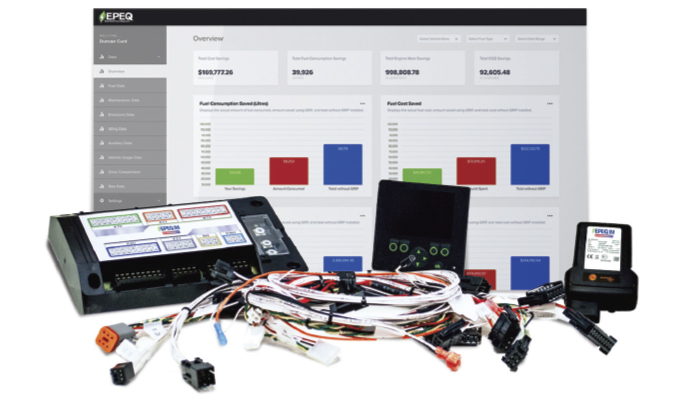In an era where every operational decision can impact a fleet’s profitability, managers are increasingly turning their attention to an often-overlooked drain on resources: excessive idling. While environmental concerns have traditionally driven the conversation around idle reduction, a compelling business case is emerging that’s catching the eye of cost-conscious fleet operators across industries.
“Fleets are navigating through a quickly evolving business landscape with numerous factors at play,” says Dean Strathman, vice president of sales, Vanair. “The pace of change we’re seeing now is unprecedented in our experience, and idle reduction is quickly becoming a key strategy for operational efficiency.”

HIDDEN COSTS OF IDLING
At first glance, allowing a vehicle to idle seems inconsequential. However, when multiplied across an entire fleet and over time, the monetary impact becomes staggering.
Consider these factors:
- Fuel Waste: Every hour of unnecessary idling burns approximately 0.8 gallons of fuel. For a fleet of 100 vehicles idling just two hours a day, that’s 160 gallons wasted daily.
- Increased Maintenance: Idling puts wear on engines equivalent to miles driven. This accelerates the need for oil changes, filter replacements, and other routine maintenance.
- Shortened Vehicle Lifespan: Excessive idling can significantly reduce the operational life of a vehicle, forcing earlier replacements and increasing capital expenditures.
- Lost Productivity: Time spent refueling and in additional maintenance reduces the hours vehicles are available for revenue-generating activities.
One Midwest-based heavy construction fleet learned this lesson the hard way. After experiencing premature engine failures across multiple vehicles due to excessive field idling, they needed a solution.
“This customer was facing significant unexpected costs from burned-out engines,” says Strathman. “They recognized that finding a way to reduce idling wasn’t just about saving fuel – it was about preserving their entire fleet investment.”
IDLE MANAGEMENT SOLUTION
A technology designed to automatically control vehicle idling based on predefined parameters, can power essential functions – from cabin climate control to truck-mounted equipment – without running the main engine, dramatically cutting unnecessary idle time.
A large Southwest construction equipment dealership discovered the true value of this approach after an eye-opening analysis of their fleet operations. Despite previously investing in auxiliary power units (APUs) to reduce idling, telematics data from their 500 service vehicles showed minimal improvement in idle times.
“They found that operators were still idling vehicles for comfort, running HVAC systems in extreme weather,” says Strathman. “With Vanair’s EPEQ Idle Management (EPEQ IM) system, they can now provide that comfort and maintain productivity without the engine running, truly realizing the benefits they were originally seeking.”

FINANCIAL UPSIDE OF IDLING DOWN
Let’s break down the potential savings for a mid-sized fleet.
Fuel Savings
- Assume 50 vehicles in the fleet.
- Average idling reduction of two hours per day, per vehicle.
- Fuel cost at $3.50 per gallon.
- Annual fuel savings: 50 vehicles x two hours x 0.8 gallons x $3.50 x 260 working days = $364,000.
Maintenance Reduction
- Estimated 30 percent reduction in oil changes and filter replacements.
- Average annual maintenance cost per vehicle: $5,000.
- 30 percent savings on 50 vehicles = $75,000.
Extended Vehicle Lifespan:
- Average vehicle replacement cost: $50,000.
- If reduced idling extends vehicle life by just one year for 10 percent of the fleet.
- Five vehicles x $50,000 = $250,000 in deferred capital expenditure.
- Total potential annual savings for a mid-sized fleet of 50 vehicles is $689,000.
These figures demonstrate why fleet managers are increasingly viewing idle reduction not as a cost, but as an investment with a rapid and significant return.
BEYOND THE NUMBERS: OPERATIONAL BENEFITS
The advantages of implementing an idle management system extend beyond direct cost savings.
- Improved Reliability: By reducing engine wear, vehicles are less likely to experience unexpected breakdowns, improving overall fleet reliability and customer service.
- Enhanced Productivity: With less time spent on refueling and maintenance, vehicles and operators can focus more on revenue-generating activities.
- Operational Flexibility: Systems like EPEQ IM allow for customization based on specific fleet needs, ensuring that critical functions are always available without compromising efficiency.
- Data-Driven Decision Making: The telematics capabilities of idle management systems, provide fleet managers with invaluable data on vehicle usage, enabling more informed decisions on fleet composition and deployment.
- Reduced Noise and Fume Exposure: Because these systems use no internal combustion engine, workers and bystanders are not exposed to the associated noise, heat, and fumes.
“Our customers are consistently surprised by the insights they gain from the EPEQ IM system’s telematics. It’s not just about reducing idling – it’s about understanding and optimizing their entire fleet operation,” says Strathman.
OVERCOMING IMPLEMENTATION CHALLENGES
Despite the clear benefits, some fleets hesitate to adopt idle management technologies due to concerns about upfront costs or potential resistance from operators.
However, these challenges are often overstated and easily mitigated.
- Return on Investment: While there is an initial investment, the payback period is typically short. Many fleets report recouping their costs within the first year of implementation.
- Operator Acceptance: Advanced systems are designed to maintain operator comfort and productivity. By clearly communicating the benefits and providing proper training, most operators quickly adapt and appreciate the improved working conditions.
- Customization: Not all fleets are the same, and idle management solutions shouldn’t be one-size-fits-all. Systems can be tailored to meet specific operational requirements, ensuring that critical functions are never compromised.
- Scalability, Versatility and Productivity: The EPEQ system, centered around Vanair’s ELiMENT brand lithium iron phosphate (LiFePO4) battery, offers a scalable “ecosystem” that adapts to diverse fleet needs. This comprehensive solution includes welders, air compressors, hydraulic power, converters, inverters and even EV charging capabilities, enabling operators to get their work done in an idle-free environment.

FUTUREPROOFING YOUR FLEET
As the commercial vehicle industry continues its march towards electrification, investing in idle management technology serves as a bridge strategy. It allows fleets to significantly reduce operational costs and extend the life of their current vehicles today, while waiting for the electric vehicle market to mature.
“Fleets implementing idle management solutions now are not just solving an immediate problem – they’re positioning themselves for a smoother transition to whatever the future of fleet operations holds,” says Strathman.
Moreover, the data and operational insights gained from these systems will prove invaluable in planning for future fleet compositions, whether they include traditional internal combustion engines, hybrid vehicles, or full electric solutions.
THE PATH FORWARD
The business case for idle reduction is clear and compelling. From immediate cost savings to long-term operational improvements, the benefits touch every aspect of fleet management. As more companies realize the significant return on investment that idle management solutions offer, we’re likely to see widespread adoption across industries.
For fleet managers looking to stay competitive in an increasingly challenging business environment, implementing an idle reduction strategy isn’t just smart – it’s becoming necessary. With solutions like EPEQ IM, fleets have access to sophisticated, customizable technology that can drive significant improvements to their bottom line.
“In the end, the question isn’t whether fleets can afford to implement idle management solutions – it’s whether they can afford not to,” says Strathman. “As the industry continues to evolve, those who act now to optimize their operations will find themselves at a distinct advantage, powered by efficiency and driven by data-backed decisions.”
For More Information
To learn more about Vanair, EPEQ Idle Management and the EPEQ IM Ecosystem, visit www.vanair.com.




